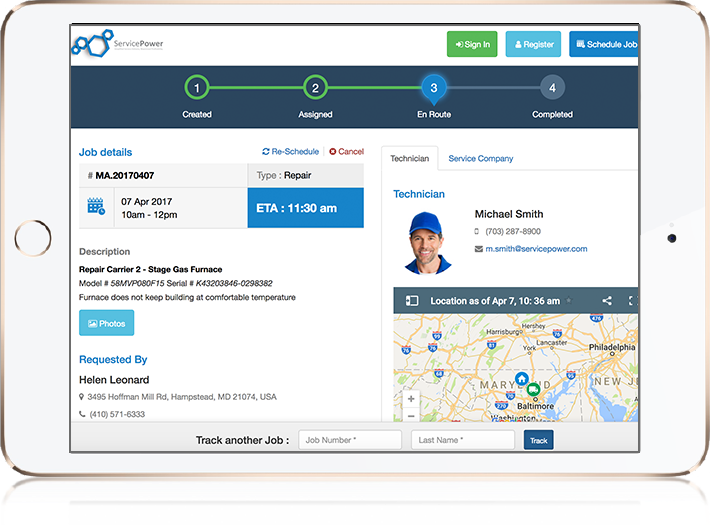Field service organizations today are experiencing a skills shortage fueled by an aging workforce and an increasing demand for skilled labor. In fact, analysts estimate that the skills shortage is already impacting over 70% of field service companies. Likewise, organizations are looking to technology for ways to overcome this critical challenge, and that’s where workforce management software comes in.
In this post, we’ll examine the key components of workforce management software, cover the benefits, review evaluation considerations, and make the case for adopting this innovative technology.
What is Workforce Management Software in the Field Service Industry?
Workforce management software is a digital solution that manages field technician scheduling and operational processes to augment employee productivity and improve service efficiency. Workforce management software features include AI-driven scheduling, dispatching, route optimization, inventory management, contractor management, and claims management. With field technicians working primarily on the go, an intuitive mobile application is also an important aspect of workforce management software.
Key Workforce Management Software Benefits
Deploying workforce management software empowers field service organizations to address and solve the main challenges of the skills shortage. These benefits include:
- Leveraging a blended workforce – Intelligent workforce management software makes it easier for field service organizations to leverage a blended workforce composed of full-time employees and third-party contractors. By diversifying the workforce, organizations can access an increasing number of field technicians with unique and valuable skills in a wider geographic range. Moreover, the flexibility of a blended workforce helps companies overcome the challenge of fluctuating demand for services.
- Increasing efficiency – Traditionally, manually dispatching and scheduling field technicians is time-consuming and labor-intensive. Field service management software that utilizes AI can help Field Service Organizations (FSOs) quickly ensure that the field technician with the right skills is sent to the right job. In addition, the ideal workforce management solution drives efficiency with real-time access to customer history, jobs, parts, inventory, and warranty-related information. The best solutions obviate the need for field service technicians to travel long distances to file paperwork, empowering them to complete critical work orders and job information all on mobile devices.
- Improving productivity – Innovative workforce management software can harness emerging technology such as Augmented Reality (AR) to drive remote support capabilities. For example, remote field technicians can use AR to access the information they need to complete a difficult service job on the first try. This benefit specifically addresses the skills gap that many FSOs are experiencing; and, in doing so, can improve first-time fix rates.
- Improving field technician retention – The modern field service organization realizes the importance of not only customer satisfaction but workforce satisfaction and technician retention. The right workforce management software solution empowers and enables the workforce to do their jobs efficiently. Flexibility, smart dispatch and route optimization, improved communication, and innovative technology are all factors that influence a technician’s decision to continue to work with an organization.
- Increasing customer satisfaction – Field service management software, and in particular, the workforce management software functionality, provides FSOs with heightened control and visibility into the customer experience. Businesses gain more insights into how their workforce interacts with the customer and how well the customer is satisfied. Feedback and customer survey components within the customer portal can help collect these actionable insights.
7 Critical Components of Workforce Management Software
Field service organizations looking to stay digitally competitive should note several key considerations when evaluating workforce management software solutions.
- Integrated solution – An integrated workforce management solution allows for ease of use and access to real-time data such as customer information, appliance details, parts inventory, work orders, scheduling, payments, etc. Selecting a holistic solution is a better short-term and long-term strategy for joining the digital transformation, whereas hobbling together disparate solutions can cause expensive technical difficulties.
- Works with a blended workforce – FSOs that manage a blended workforce need a solution that addresses this specific need. Workforce management software that manages a blended workforce can improve overall workforce availability, performance, and quality by increasing the utilization of technicians and resulting in a higher number of service jobs and overall profits.
- Mobile platform-enabled – Select a software solution that is mobile-enabled to drive greater efficiency, productivity, and autonomy with the mobile workforce. Whether deploying AI scheduling, AR remote access, location-based technology, or other useful technology, the mobile application should be an integrated component of the workforce management software
- Data-driven with analytical insights – Workforce management software should deliver strategic and actionable insights that are unique for every business. FSOs can use these data-driven insights to visualize business value, improve workforce deployment, adjust service delivery, and more.
- Built for agility and scale – Field service organizations realize the rapidly changing customer, workforce, and technology landscape. Look for a solution that enables the agility to quickly scale capacity, geography, or skills without the time and cost of recruitment.
- Configurable – Consider a solution that delivers a modicum of customization based on key business drivers. Not all FSOs are the same, so it’s important to deploy a field service management software solution that can address your specific needs and challenges.
- Simple but powerful user interface – Deploying innovative technology is not enough; it needs to be easily adopted by the end-user, which includes the business, customers, and workforce. Software must be cutting-edge but also intuitive to engage all of the users and encourage them to quickly adopt the solution. If the workforce software is too complex or clumsy to use, the business runs the risk of low adoption, not to mention a wasted investment.
Investing in Intelligent, Integrated Workforce Management Software
The modern field service organization embraces technology such as workforce management software to help overcome the challenges brought by the evolving skills shortage. Adopting innovative technology can help close the gap in these field technician shortages while driving efficiency, technician retention, customer satisfaction, and profitability. However, FSOS must deploy software that works with a blended workforce and meets all the key evaluation criteria. Field service organizations that partner with the best workforce management software provider can better position themselves for agility, digital innovation, and success today and for whatever changes unfold in the future.
Explore how Service Power’s workforce management solution helps field service organizations manage a blended workforce all while maximizing time to ROI.



